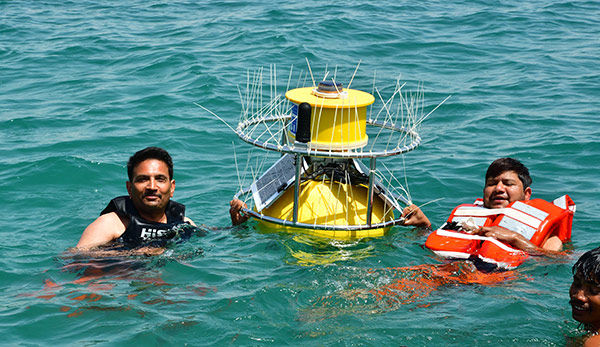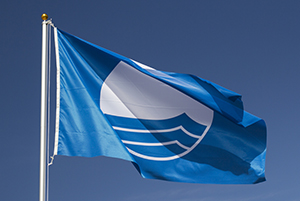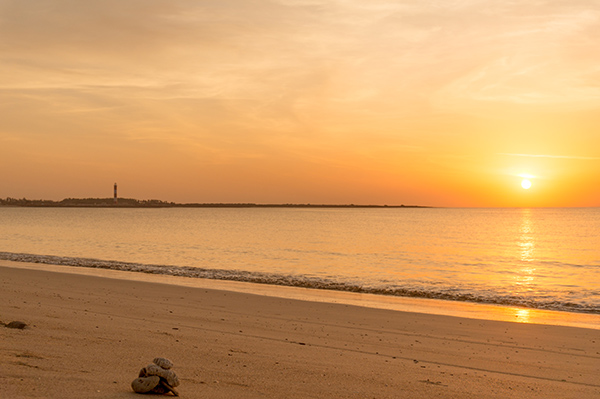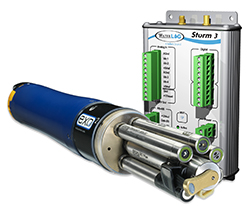Updated Monitoring System Helps Buoy the Reputation of Shivrajpur Beach

The YSI EMM68 coastal buoy, shown with anti-bird "spikes" (zip ties).
(Updated November 2021)
On the edge of the Arabian Sea in the Indian state of Gujarat, Shivrajpur Beach is an arc of white sand cupping turquoise waters just north of the ancient Hindu pilgrimage sites of Dwarka. “Dwarka” means “gateway to heaven” in Sanskrit, and for lovers of a day on the beach, it’s easy to imagine that heaven might look a lot like Shivrajpur. The semi-isolated beach is a favorite of families out for a day at the seaside, a place to relax after a pilgrimage to the elaborately tiered, 16th century Dwarakadhish Temple that sits on a site said to be the home of Lord Krishna himself.
Unlike many beaches in India, Shivrajpur is far from industrial sites and megacities, which helps keep the local environment clean. Its relatively rural location and excellent water quality has made Shivrajpur Beach a strong contender for the coveted title of Blue Flag Beach, a global eco-label that recognizes top-quality beaches, marinas and boating tourism operations.
Blue Flag Beaches
Since its first appearance in 1985, the wave-and-circle graphic of the international Blue Flag program flying over a beach has been a symbol of compliance with a long list of criteria, from water quality and sustainable environmental management to extensive safety measures. Administered by the Foundation for Environmental Education (FEE) in Denmark, the Blue Flag program has recognized more than 4,000 sites in nearly 50 countries around the world. Communities prize the Blue Flag—accreditations are often referred to as “awards”—because they are attractive to tourists and reflect strong community support for the local maritime environment.
When India’s Environmental Ministry set out to earn a Blue Flag accreditation for one beach in each of the country’s coastal states, Gujarat officials focused their efforts on Shivrajpur Beach. The Gujarat Ecology Commission (GEC) established a Beach Management Committee in Dwarka and began the process of applying for the award.
One of the key requirements for accreditation is to establish water quality monitoring. With funds from the Indian government’s Integrated Coastal Zone Management Programme, the commission worked with Xylem’s partner A&S Creations to select the best technologies for this application. The GEC scientists saw 10 YSI EMM68 buoys in Chilika Lake on India’s east coast and were impressed with their performance, according to Rajiv Bhatia, Xylem Analytics’ Manager for Surface Water in the company’s Gurgaon office, near the capital of New Delhi.
Water Quality Monitoring at Shivrajpur Beach
Bhatia says GEC selected the YSI EMM68 coastal buoy because it is lightweight enough for two technicians in a small boat to deploy and retrieve without divers, reducing installation and maintenance costs.

Shivrajpur Beach with it's white sands bathed in golden light from a setting sun.
Despite the buoy’s light weight—just 48 kg—and easy handling, it is highly secure and difficult to steal or vandalize, Bhatia notes. A solar panel on the buoy maintains a charge in the system’s 12-volt battery, which powers a high-luminosity beacon to ward off watercraft at night. [Watch video EMM68 Buoy Overview]
Mounted to the buoy is a YSI EXO2 multiparameter water quality sonde. Through its six sensor ports, the EXO2 continually measures temperature, conductivity, salinity, turbidity and total dissolved solids (TDS), dissolved oxygen (DO), pH, oxidative-reductive potential (ORP), chlorophyll, fluorescent dissolved organic matter (fDOM) and phycoerythrin—a pigment of blue-green algae—every 15 minutes. The sonde’s seventh port houses a central anti-fouling wiper, which helps ensure accuracy and lengthen the interval between maintenance visits, notes Bhatia, who added that biofouling can be a constant challenge in the Arabian Sea. (Learn more, 7 Tips to Fight Fouling and Extend Water Quality Sonde Deployments).
The EXO2 sonde is equipped with YSI’s SmartQC™ system, which streamlines the sensor calibration process during deployment and maintenance. Calibration is simple with the plug-and-play sensors of the EXO2, which carry their own calibration information. A sensor can be calibrated in the laboratory, for instance, and then placed into a sensor port on the EXO2 sonde in the field without requiring any recalibration. This “hot swap” feature enables the sensor to begin providing real-time data immediately, and the calibration information is always available so that quick calibration checks can be performed in the field, as well as on-site calibration when that is necessary.
“The EMM68 coastal buoy and EXO2 sonde are ideal for a deployment like Shivrajpur Beach, where durability, reliability and versatility are so important,” says Dr. Stephanie A. Smith, YSI’s Product Segment Manager for Outdoor Water Quality.
“The Gujarat Environmental Commission has begun a steady, massive flow of continuous water quality data that will not only provide the quality and level of detail required to participate in the Blue Flag program, but that could also someday provide great insight into water quality in one of western India’s most beautiful coastal communities.
“That data flow is facilitated by a YSI Storm3 data logger, which transmits the data via GSM GPRS modem to YSI’s HydroSphereTM data visualization platform for outdoor water monitoring. The customized data collection platform makes the data available for viewing by the GEC and researchers whom they authorize to view the data from anywhere in the world, at any time.
Dr. Smith notes that continuous monitoring can deliver more than ‘round the clock assurance of high water quality. It can reveal the hidden dynamics of the local environment. “A continuous stream of data from the EXO2 provides the GEC an opportunity to observe seasonal or diurnal cycles, or even individual events, such as algae blooms or illicit discharges that can impact the pristine nature of the site,” she says. “It creates the opportunity to really understand what goes on in the system, and how it is influenced by a wide range of variables.” This approach will help Shivrajpur Beach to monitor water quality and, when necessary, take action to protect this pristine environment, for years to come.
Update -
In October 2020, India’s plan to certify Blue Flag beaches was met with unprecedented success – eight of its beaches were awarded Blue Flag status, including Shivrajpur Beach.
“Proud moment for India; all 8 beaches recommended by government gets coveted International #Blueflag Certification,” wrote India’s Union Minister of Environment, Forest and Climate Change Shri Prakash Javadekar on Twitter.
“The #Blueflag certification accorded to India’s 8 beaches by an international jury,” he continued, “is also a global recognition of India’s conservation and sustainable development efforts.”


Additional Blog Posts of Interest
Networks that Work | Narragansett Bay Fixed-Site Monitoring Network
Water Quality Monitoring with Vehicles for Better Coverage
For the Love of Charles | A River on the Rebound
Data-Driven Decisions Improve Lake Health